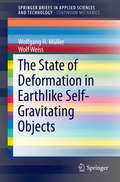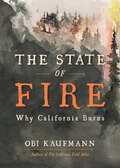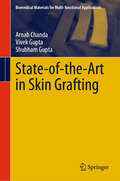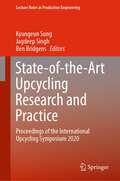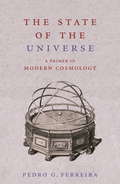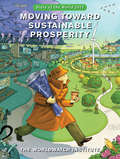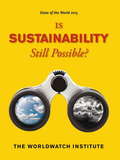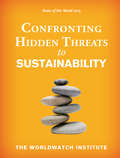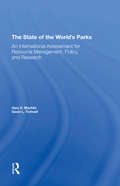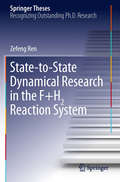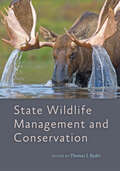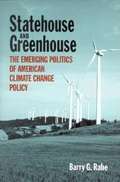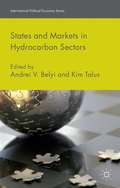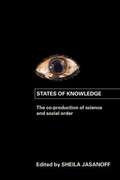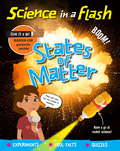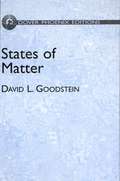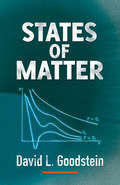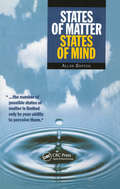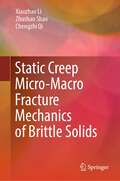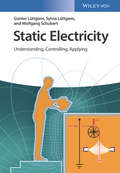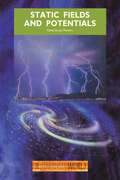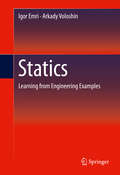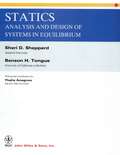- Table View
- List View
The State of Deformation in Earthlike Self-Gravitating Objects
by Wolfgang H. Müller Wolf WeissThis book presents an in-depth continuum mechanics analysis of the deformation due to self-gravitation in terrestrial objects, such as the inner planets, rocky moons and asteroids. Following a brief history of the problem, modern continuum mechanics tools are presented in order to derive the underlying field equations, both for solid and fluid material models. Various numerical solution techniques are discussed, such as Runge-Kutta integration, series expansion, finite differences, and (adaptive) FE analysis. Analytical solutions for selected special cases, which are worked out in detail, are also included. All of these methods are then applied to the problem, quantitative results are compared, and the pros and cons of the analytical solutions and of all the numerical methods are discussed. The book culminates in a multi-layer model for planet Earth according to the PREM Model (Preliminary Earth Model) and in a viscoelastic analysis of the deformation problem, all from the viewpoint of rational continuum theory and numerical analysis.
The State of Fire: Why California Burns
by Obi KaufmannHow do we live with fire? From the creator of The California Field Atlas, a book of stewardship, resilience, and hope.Fire is an essential part of California's ecology. Humans have been using it to shape the California landscape for thousands of years. But today many Californians' relationship to fire is one of fear. Obi Kaufmann, author of the best-selling California Field Atlas, now asks: How do we live with fire? What makes fire essential to a healthy and biodiverse Golden State, and how do we benefit from its teachings? With the same solution-minded ethic as his much-admired The State of Water: Understanding California's Most Precious Resource, Kaufmann presents fire as a force of regeneration rather than apocalypse. He considers the long history of ecological burns, the varied ways fire behaves across the state, and the lessons we can learn from California's largest fires of recent decades.Packed with Kaufmann's signature watercolor maps and paintings, The State of Fire confronts one of California's most pressing social and ecological challenges. From this maelstrom Kaufmann emerges to share a deepened love for the natural world—and a refreshingly hopeful vision of California's future.
State-of-the-Art in Skin Grafting (Biomedical Materials for Multi-functional Applications)
by Vivek Gupta Arnab Chanda Shubham GuptaThis book discusses the different skin grafting methods, latest trends in graft designing, and its relationship with the burn injuries. An introduction to several conventional and modern skin grafting methods and how crucial the innovation is for recovery of large burns will be presented. The technologies involved in the development of skin grafts incisions, and study of their effect on the mechanical properties and systematically modified skin graft patterns, will be covered at length. The development of skin grafts using conventional, auxetic, and hierarchical patterns through computational and experimental frameworks will be discussed in detail. Also, the role of skin graft patterns on the mechanical stresses, expansion ratio or meshing ratio, will be presented. Additionally, the role of degree of burn, size of burn, and region of burn will be discussed, and its generalizability will be covered in detail. Finally, the challenges with the existing skin graft meshers and latest development in this niche area will be highlighted. This book is anticipated to serve as a key reference for medical and research professionals working in the skin grafting domain as well as the product manufacturing industries. For example, skin grafting plays an important role to cure the serious burn injuries. Current innovative skin graft patterns which cover higher area compared to traditional skin graft patterns are anticipated to help in surgery and faster recovery of larger burnt areas. Also, the current skin graft mesher, which is used to develop traditional skin grafts, cannot produce claimed expansions clinically. This book helps design novel mesher devices to reduce the difference between actual and claimed expansions clinically and increase the skin graft coverage area to recover burn sites with lesser available skin. This book is equally useful for students of medical practices, manufacturing engineering, and design engineering.
State-of-the-Art Upcycling Research and Practice: Proceedings of the International Upcycling Symposium 2020 (Lecture Notes in Production Engineering)
by Kyungeun Sung Jagdeep Singh Ben BridgensThis book presents the proceedings of the first International Upcycling Symposium 2020, held on 4th September 2020 at De Montfort University (DMU) in Leicester, UK (online), as a joint effort between DMU, Lund University, Nottingham Trent University and Newcastle University. This book presents state of the art of research and practice in “upcycling” at the international level.The subject of this book, upcycling, is a term to describe the processes of creating or modifying a product from used or waste materials, components and products, which is of equal or higher quality or value than the compositional elements. This book describes new theories, approaches and scientific research findings related to upcycling and presents examples of upcycling practice, across multiple sectors, scales and contexts. Bringing together research from over 35 multidisciplinary experts, the book discusses state-of-the-art knowledge and practices on upcycling in different geographical, economic, socio-cultural and technological contexts at an international level. Readers will gain fundamental understanding of upcycling with its varied definitions and forms across sectors and scales, and to be informed of the latest upcycling research and practices including valuable ideas, theories, projects, experiences and insights by global experts.
The State of the Universe: A Primer In Modern Cosmology
by Pedro FerreiraA masterly overview of the development of cosmological thinking from the Greeks, via Newton and Einstein, to the present day.It is science's last and greatest challenge: fathoming the depths of the night sky. The objective: to crack the cosmic code, to unravel the blueprint for nature's grandest conception, a machine constructed on an unimaginably vast scale - the Universe itself. Today's model of an expanding Universe - the big bang cosmology - is actually built on principles derived from a few simple mathematical equations. Gravity-warped space time, quantum mechanics, the physics of the subatomic, these crucial insights, stemming from Einstein's revolutionary theories of relativity, have led to a simple and elegant framework within which the whole of the Universe, over billions of years, has been described.But recent evidence has begun to make wrinkles in the neat fabric of the big bang cosmology. There is now overwhelming evidence that there is far more stuff in the Universe than we can see. What, and where, is this 'dark matter'? And it now appears that the expansion of the Universe is accelerating: something out there - some exotic 'dark energy' - is acting against gravity to push space and time apart. While offering a critical view of how all the pieces in our current model fit together, Pedro Ferreira argues that Einstein's Universe may be just another stepping stone towards a new, more profound and effective cosmology in the future.
The State of the Universe: A Primer in Modern Cosmology
by Pedro FerreiraA masterly overview of the development of cosmological thinking from the Greeks, via Newton and Einstein, to the present day.It is science's last and greatest challenge: fathoming the depths of the night sky. The objective: to crack the cosmic code, to unravel the blueprint for nature's grandest conception, a machine constructed on an unimaginably vast scale - the Universe itself. Today's model of an expanding Universe - the big bang cosmology - is actually built on principles derived from a few simple mathematical equations. Gravity-warped space time, quantum mechanics, the physics of the subatomic, these crucial insights, stemming from Einstein's revolutionary theories of relativity, have led to a simple and elegant framework within which the whole of the Universe, over billions of years, has been described.But recent evidence has begun to make wrinkles in the neat fabric of the big bang cosmology. There is now overwhelming evidence that there is far more stuff in the Universe than we can see. What, and where, is this 'dark matter'? And it now appears that the expansion of the Universe is accelerating: something out there - some exotic 'dark energy' - is acting against gravity to push space and time apart. While offering a critical view of how all the pieces in our current model fit together, Pedro Ferreira argues that Einstein's Universe may be just another stepping stone towards a new, more profound and effective cosmology in the future.
State of the World 2012: Moving Toward Sustainable Prosperity (State of the World)
by The The Worldwatch InstituteIn the 2012 edition of its flagship report, Worldwatch celebrates the twentieth anniversary of the 1992 Earth Summit with a far-reaching analysis of progress toward building sustainable economies. Written in clear language with easy-to-read charts, State of the World 2012 offers a new perspective on what changes and policies will be necessary to make sustainability a permanent feature of the world's economies. The Worldwatch Institute has been named one of the top three environmental think tanks in the world by the University of Pennsylvania's Think Tanks and Civil Societies Program.
State of the World 2013: Is Sustainability Still Possible?
by The Worldwatch InstituteEvery day, we are presented with a range of "sustainable" products and activities--from "green" cleaning supplies to carbon offsets--but with so much labeled as "sustainable," the term has become essentially sustainababble, at best indicating a practice or product slightly less damaging than the conventional alternative. Is it time to abandon the concept altogether, or can we find an accurate way to measure sustainability? If so, how can we achieve it? And if not, how can we best prepare for the coming ecological decline? In the latest edition of Worldwatch Institute's State of the World series, scientists, policy experts, and thought leaders tackle these questions, attempting to restore meaning to sustainability as more than just a marketing tool. In State of the World 2013: Is Sustainability Still Possible?, experts define clear sustainability metrics and examine various policies and perspectives, including geoengineering, corporate transformation, and changes in agricultural policy, that could put us on the path to prosperity without diminishing the well-being of future generations. If these approaches fall short, the final chapters explore ways to prepare for drastic environmental change and resource depletion, such as strengthening democracy and societal resilience, protecting cultural heritage, and dealing with increased conflict and migration flows. State of the World 2013 cuts through the rhetoric surrounding sustainability, offering a broad and realistic look at how close we are to fulfilling it today and which practices and policies will steer us in the right direction. This book will be especially useful for policymakers, environmental nonprofits, and students of environmental studies, sustainability, or economics.
State of the World 2015: Confronting Hidden Threats to Sustainability
by The Worldwatch InstituteWe think we understand environmental damage: pollution, water scarcity, a warming world. But these problems are just the tip of the iceberg. Food insecurity, financial assets drained of value by environmental damage, and a rapid rise in diseases of animal originare among the underreported consequences of an unsustainable global system. In State of the World 2015, the flagship publication of The Worldwatch Institute, experts explore hidden threats to sustainability and howto address them. How will nations deal with migration as climate change refugees cross borders in order to escape flooding, drought, or other extreme weather events? What will happen to the price and availability offossil energy--the foundation of industrial civilization--as these resources oscillate between surplus and scarcity? If perpetual economic growth on a finite planet is impossible, what are the alternatives? Can national governments manage the transition?Eight key issues are addressed in depth,along with the central question ofhow we can develop resilience to these and other shocks. For decades, The Worldwatch Institute has been a leader in identifying and analyzing emerging environmental threats. With the latest edition of State of The World, the authorities at Worldwatch bring to light challenges we can no longer afford to ignore.
The State Of The World's Parks: An International Assessment For Resource Management, Policy, And Research
by Gary E Machlis David L. TichnellNational parks are a global phenomenon found in more than 120 countries. These parks are as diverse as the physical settings and cultural patterns of the many nations that have established them, yet within each country they serve as part of the cohesiveness that binds people together. Parks reflect-and help create-people's pride and love for their national heritage.
State Space Consistency and Differentiability
by Demetrios SerakosBy investigating the properties of the natural state, this book presents an analysis of input-output systems with regard to the mathematical concept of state. The state of a system condenses the effects of past inputs to the system in a useful manner. This monograph emphasizes two main properties of the natural state; the first has to do with the possibility of determining the input-output system from its natural state set and the second deals with differentiability properties involving the natural state inherited from the input-output system, including differentiability of the natural state and natural state trajectories. The results presented in this title aid in modeling physical systems since system identification from a state set holds in most models. Researchers and engineers working in electrical, aerospace, mechanical, and chemical fields along with applied mathematicians working in systems or differential equations will find this title useful due to its rigorous mathematics.
State-to-State Dynamical Research in the F+H2 Reaction System
by Zefeng RenThis thesis addresses two important and also challenging issues in the research of chemical reaction dynamics of F+H2 system. One is to probe the reaction resonance and the other is to determine the extent of the breakdown of the Born-Oppenheimer approximation (BOA) experimentally. The author introduces a state-of-the-art crossed molecular beam-scattering apparatus using a hydrogen atom Rydberg "tagging" time-of-flight method, and presents thorough state-to-state experimental studies to address the above issues. The author also describes the observation of the Feshbach resonance in the F+H2 reaction, a precise measurement of the differential cross section in the F+HD reaction, and validation of a new accurate potential energy surface with spectroscopic accuracy. Moreover, the author determines the reactivity ratio between the ground state F(2P3/2) and the excited state F*(2P1/2) in the F+D2 reaction, and exploits the breakdown of BOA in the low collision energy.
State Wildlife Management and Conservation (Wildlife Management and Conservation)
by Thomas J. RyderAn illuminating look at the challenges and triumphs of state wildlife professionals at the forefront of the fight to protect the American wilderness.The adage "think globally but act locally" defines the work of American wildlife professionals. Their contributions, from remote outposts to major cities, guard the natural world of the entire country. In State Wildlife Management and Conservation, Thomas J. Ryder brings together wildlife leaders from practical, policy, and academic backgrounds to tell the story of state wildlife agencies, chronicling their efforts to restore and protect our nation's natural resources.Reflecting the core principle of the profession—that the public, not any individual, owns wildlife—the book explains how this tenet became law, laying the groundwork for the history of state-level wildlife management that follows. The authors cover key issues, including the limits of private land ownership, the funding of wildlife regulation, the nuances of humanwildlife conflict, the role of law enforcement, disease control efforts, and the challenges involved in balancing the perspectives of hunters, nonhunters, and animal rights advocates. Detailed essays also discuss state management techniques for a wide range of wildlife, including big game and migratory birds. State Wildlife Management and Conservation is a comprehensive, nationwide account of state management efforts. It will aid professors training the next generation of wildlife professionals, students hoping to enter the profession, and anyone working with wildlife to develop a more sophisticated understanding of what it means to be a state wildlife biologist. Contributors: M. Carol Bambery, Gordon R. Batcheller, Chad J. Bishop, Vernon C. Bleich, Dale Caveny, David K. Dahlgren, Daniel J. Decker, Karie L. Decker, Thomas A. Decker, Billy Dukes, John D. Erb, John R. Fischer, Ann B. Forstchen, Jonathan W. Gassett, Parks Gilbert, Colin M. Gillin, Tim L. Hiller, Daniel Hirchert, Michael W. Hubbard, Mark Humpert, Scott Hygnstrom, Robert P. Lanka, Richard E. McCabe, Jennifer Mock-Schaeffer, Brian Nesvik, Shaun L. Oldenburger, John F. Organ, Ronald J. Regan, Michael A. Schroeder, William F. Siemer, Christian Smith, Randy Stark, Gary J. Taylor, J. Scott Taylor, Daniel J. Thompson, Kurt VerCauteren, Mark P. Vrtiska, H. Bryant White, Steven A. Williams
Statehouse and Greenhouse: The Emerging Politics of American Climate Change Policy
by Barry G. RabeNo environmental issue triggers such feelings of hopelessness as global climate change. Many areas of the world, including regions of the United States, have experienced a wide range of unusually dramatic weather events recently.
States and Markets in Hydrocarbon Sectors
by Andrei V. Belyi Kim TalusResearch on the role of states and markets in the hydrocarbon sector is highly topical in contemporary International Political Economy. This edited collection will approach this subject from a broader perspective, investigating the very essence of the interaction between the state and the market and how this varies on a regional basis.
States of Knowledge: The Co-Production of Science and the Social Order
by Sheila JasanoffIn the past twenty years, the field of science and technology studies (S&TS) has made considerable progress toward illuminating the relationship between scientific knowledge and political power. These insights are now ready to be synthesized and presented in forms that systematically highlight the connections between S&TS and other social sciences. This timely collection of essays by leading scholars in the field meets this challenge. The book develops the theme of 'co-production', showing how scientific knowledge both embeds and is embedded in social identities, institutions, representations and discourses. Accordingly, the authors argue, ways of knowing the world are inseparably linked to the ways in which people seek to organize and control it. Through studies of emerging knowledges, research practices and political institutions, the authors demonstrate that the idiom of co-production importantly extends the vocabulary of the traditional social sciences, offering fresh analytic perspectives on the nexus of science, power and culture.
States of Matter: Rocks Science ... In A Flash: Rocks (Science in a Flash #35)
by Georgia Amson-BradshawHelp kids discover science - in a flash!What's the matter? Are you in a state over evaporation and condensation? Don't worry - this book will give you the low-down on liquids, a summary about solids and the goods on gases ... and more!This essential KS2 series for children aged 7 and up covers all the key science topics in energetic, quick-fire way, aiding clear comprehension by getting straight to the point! Each spread starts with a 'flash' or headline, summing-up succinctly the science information to follow. Attractive and light-hearted illustration visually conveys the information, adding depth and detail to engage children. Also includes fun jokes and cartoons to keep even the most reluctant readers entertained.
States of Matter
by David L. GoodsteinOverview covers thermodynamics and statistical mechanics; gases, solids, and liquids; perfect gases; electronics in metals; and the Bose condensation. Also: structure of a fluid, potential energy, interacting gases and liquids, Weiss molecular field theory, van der Waals equation, and other pertinent aspects of phase transitions. 154 figures .1975 edition.
States of Matter (Dover Books on Physics)
by David L. GoodsteinThis unique overview by a prominent CalTech physicist provides a modern, rigorous, and integrated treatment of the key physical principles and techniques related to gases, liquids, solids, and their phase transitions. No other single volume offers such comprehensive coverage of the subject, and the treatment consistently emphasizes areas in which research results are likely to be applicable to other disciples.Starting with a chapter on thermodynamics and statistical mechanics, the text proceeds to in-depth discussions of perfect gases, electrons in metals, Bose condensation, fluid structure, potential energy, Weiss molecular field theory, van der Waals equation, and other pertinent aspects of phase transitions. Many helpful illustrative problems appear at the end of each chapter, and annotated bibliographies offer further guidance.
States of Matter, States of Mind
by Allan F.M. BartonStates of Matter, States of Mind is an easy-to-read introduction to the way the physical world is put together and stays together. The book presents the fundamental ideas and particles of the makeup of the universe to enable understanding of matter and why it behaves in the way it does. Written in an engaging manner, the book explains some of the intricate details and grand schemes of life and the universe, by making analogies with common everyday examples. For example, the recipe for a cake tells us nothing of how good the cake tastes, but is a model of the food, and a scientific model is no closer to the reality of the materials than a recipe is to the mouth-watering flavor of the cake. Illustrated with helpful cartoons, this book provides a vast knowledge of atoms and atmospheres. The first several chapters introduce terms and fundamental ideas while later chapters deal successively with particles and systems, from the electron to the universe as a system. Each new idea introduced builds upon the last. A user-friendly bibliography provides references for further reading.
Static Creep Micro-Macro Fracture Mechanics of Brittle Solids
by Xiaozhao Li Zhushan Shao Chengzhi QiThis book gathers a large amount of recent research results on this topic to better understand the static creep micro–macro fracture mechanics in brittle solids (e.g., glass, ceramic, concrete, ice, and rock). To be precise, this is about to explore the effects of the external factors of stress paths, water content, seepage pressure, dynamic disturbance, thermal treated temperature, and the internal factors of crack angle, size, recovery, and nucleation coalescence on the static creep fracture mechanical properties in brittle solids. This book provides important theoretical support in evaluation for long-term lifetime in the brittle solid engineering (e.g., deep underground engineering, architecture engineering, aerospace engineering, and mechanical manufacturing engineering).
Static Electricity: Understanding, Controlling, Applying
by Günter Lüttgens Sylvia Lüttgens Wolfgang SchubertWritten by world-renowned experts on the topic with many years of research and consultancy experience, this invaluable book provides the practitioners' perspective, outlining the dangers and benefits of static electricity in industry. The first chapter reviews the fundamentals of understanding fires and explosions in general and electricity-induced ignition in particular, while the following chapter is dedicated to the origins of static electricity in industrial settings, such as in flowing gases and the transport of disperse systems. The major part of the text deals with measuring static electricity, elimination of unwanted charges and hazard prevention under different conditions. It concludes with an overview of practical applications in chemical and mechanical engineering. Throughout the book, real-life case studies illustrate the fundamental aspects so as to further an understanding of how to control and apply static electricity and thus reduce material damages as well as increase occupational safety. Plus additional movie sequences on the dedicated website showing static electricity in action.
Static Fields and Potentials
by Joy MannersStatic Fields and Potentials describes two of the fundamental interactions in nature: gravity and electromagnetism. The book introduces the associated fields, potentials, and energies and explains the relationship among them. It shows how these interactions manifest themselves in different ways, from the formation of stars to the operation of thund
Statics
by Igor Emri Arkady VoloshinThis textbook introduces and explains the basic concepts on which statics is based utilizing real engineering examples. The authors emphasize the learning process by showing a real problem, analyzing it, simplifying it, and developing a way to solve it. This feature teaches students intuitive thinking in solving real engineering problems using the fundamentals of Newton's laws. This book also: · Stresses representation of physical reality in ways that allow students to solve problems and obtain meaningful results · Emphasizes identification of important features of the structure that should be included in a model and which features may be omitted · Facilitates students' understanding and mastery of the "flow of thinking" practiced by professional engineers
Statics: Analysis And Design Of Systems In Equilibrium
by Sheri D. Sheppard Benson H. TongueStatics: Analysis and Design of Systems in Equilibrium, by Sheri D. Sheppard of Stanford University, and Benson H. Tongue, University of California, Berkeley, offers a student-focused approach to Statics. With a strong emphasis on drawing free body diagrams, use of a structured problem-solving methodology, inclusion of real-world case studies, and robust pedagogy coupled with a truly engaging writing style, reviewers alike have praised this new Statics text. Additionally, this first edition has benefited from a comprehensive and thorough accuracy check by 15 experienced professors, and has been reviewed by more than 200 Statics and Dynamics professors. The text seeks to improve students’ abilities to map their understanding to more realistic engineering situations, enabling them to more effectively break down complex problems into manageable parts, and thus, become more effective engineering students and ultimately, professional engineers. The authors do not compromise on rigor. Instead this series demonstrates the required rigor in the larger context of engineering work, decision making, problem solving, and understanding and impacting the man-made world.
